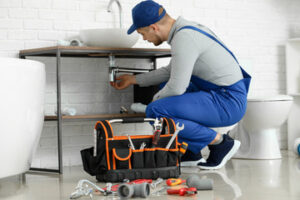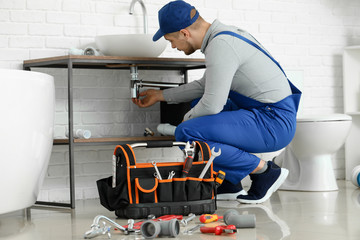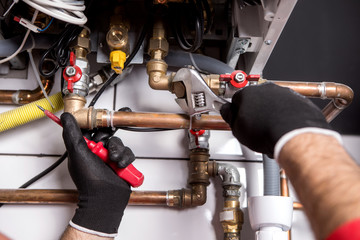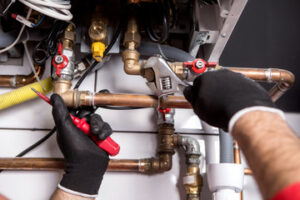Plumbers Bradenton are best known for showing up when a pipe bursts in the basement or the water heater stops working. But they also play a key role in new construction and commercial settings, consulting blueprints and installing or maintaining piping systems and fixtures.
Plumbing is considered a recession-proof job because every home, business and public building needs functioning water and sewage systems. Read on to discover the many other reasons to love being a plumber.
Water is an essential resource for human life, providing us with vital functions like circulation, temperature regulation, and waste elimination. But not all water is safe to consume or use. Unsafe and contaminated water can cause a wide range of health problems, from minor skin irritation to serious diseases like cholera and dysentery. Fortunately, plumbers help ensure that we have access to clean water by installing and maintaining filtration and purification systems.
Whole-house water filtration systems eliminate unhealthy chemicals and bacteria from home drinking water supplies, ensuring that family members enjoy fresh, healthy water. These filtration systems work by removing contaminants from the water supply through a process of heating, vaporization, and condensation. They also ensure that the filtered water meets government safety standards. Other water treatment options include chemical disinfection and ozonation. Both of these methods employ chlorine-based compounds to kill harmful microorganisms in drinking water, protecting families from dangerous infections.
Plumbing professionals also play a significant role in maintaining the cleanliness of public water supplies by installing backflow prevention devices and inspecting septic systems. These devices protect public water sources from contamination and sewage, reducing the risk of waterborne illnesses and allowing people to practice proper hygiene practices.
In addition, plumbers can install and maintain a variety of water-saving appliances and fixtures. These technologies reduce the amount of water we use, lowering utility bills and minimizing environmental impact. They can also advise customers on how to conserve water at home by implementing simple, cost-effective strategies such as catching rainwater for gardening or washing clothes with cold water instead of hot.
Finally, plumbing professionals can help promote cleaner, safer water by educating communities about the importance of using lead-free pipes and faucets. They can also encourage people to install and use filtered water, which is good for the environment and for their own health. This is an important part of the global effort to make clean water accessible and affordable for everyone. By promoting the use of filtration solutions and other water-saving technologies, plumbers can help ensure that all people have access to safe, clean, drinkable water for years to come.
Safe Waste Disposal
Often working in cramped spaces, it is essential for plumbers to navigate work environments safely. This involves identifying potential hazards, evaluating their severity, and planning action to mitigate them. It also includes familiarizing themselves with emergency protocols in case of unforeseen situations. For example, if a water heater bursts or there is a major leak, plumbers must know the quickest exit routes, emergency contact numbers, and where to find the nearest safety equipment.
Plumbing professionals are also concerned with reducing their environmental impact. For this reason, they advise clients on sustainable garbage disposal practices. They also perform regular inspections and cleaning to keep appliances like garbage disposals in top condition. This minimizes power usage and prevents clogs and other serious problems.
If you don’t use your disposal correctly, you can clog it and damage the motor, requiring costly repair or even replacement. For this reason, it is essential to avoid placing any food waste in the disposal. Fibrous vegetables such as celery or corn husks can wrap around the blades and jam the system. Egg shells and onion layers can also build up and clog the unit. Chemicals or harsh cleaners should never be poured down the drain, either, as they can poison sewage systems and damage the environment.
A well-maintained disposal also reduces the pressure on drainage pipes and eliminates kitchen odors. It can also save you money by eliminating the need for expensive trash bags. However, if your disposal is not running properly, you may need to call a 24-hour plumber. This is because a faulty disposal can lead to severe kitchen odors, clogs, and other costly problems.
It is important to run cold water through your disposal before and after using it to flush down the drains and remove any food particles. It is also helpful to regularly clean the disposal with natural cleaners and baking soda, as this can prevent odors and buildup. In addition, it is a good idea to run a batch-feed garbage disposal model, which only operates when the special drain cap or stopper is in place. This type of garbage disposal is safer than other models and can be especially useful in households with a septic tank system.
Sense of Satisfaction
Plumbers play a vital role in ensuring that homes and businesses have access to clean water. Moreover, they are tasked with promoting efficient water usage to reduce environmental impact. Consequently, plumbing professionals feel a sense of pride in their work. Moreover, they are motivated by the positive impact their services have on people’s lives.
However, the industry is facing a skills gap that threatens its future. Nevertheless, it is possible to bridge this gap through comprehensive training programs. These programs offer hands-on apprenticeships and a structured curriculum, enabling apprentices to acquire practical skills under the supervision of experienced professionals. Additionally, they foster a culture of continuous learning, encouraging plumbers to stay up-to-date with new technologies and techniques.
Moreover, the program helps to create a strong network of community members who can mentor apprentices in their career journey. This, in turn, helps to boost job satisfaction and the profession as a whole.
In addition, the training programs provide plumbers with a variety of professional development resources to improve their skills and boost their productivity. These resources include online courses, podcasts, and webinars that cover topics like best practices, safety procedures, and emerging technologies. These resources also enable plumbers to develop critical thinking and problem-solving skills, enabling them to quickly assess a situation and recommend the most effective solutions.
Another crucial aspect of a satisfying career for plumbers is a healthy work-life balance. This involves prioritizing tasks, delegating non-essential duties, and seeking familial support. Furthermore, it is important for plumbers to maintain a healthy lifestyle through diet and exercise. This enables them to focus better on their work and complete projects in a timely manner. Moreover, it ensures that they are present for their family events and activities, promoting stronger relationships.
Plumbers should also make it a point to encourage customer feedback and take action on negative reviews. Responding promptly and politely to negative reviews shows that a company cares about its clients’ needs and is committed to resolving any issues. Similarly, addressing disgruntled customers personally and apologizing for any mishaps is an effective way to bolster client confidence and build loyalty.
People Interaction
Plumbers must work with clients to build trust and forge a strong customer relationship. Whether they’re answering questions about how to prevent a recurring problem or offering advice on long-term improvement projects, their ability to communicate effectively is crucial for success. It also enhances satisfaction and increases the likelihood of repeat business.
Clients can often feel nervous or stressed out about a plumbing problem. Taking the time to listen attentively, respond with empathy, and provide helpful tips can ease their fears and create a bond of loyalty. This emotional intelligence, combined with technical proficiency, can help plumbers forge lasting relationships with their customers.
Many people who choose to become plumbers enjoy the sense of purpose that their work brings. They help to ensure that families and businesses have access to clean water, while providing safe wastewater disposal systems. Moreover, they play an important role in promoting sustainable living practices through eco-friendly water usage. This deeper sense of purpose can boost job satisfaction and increase the pride that plumbers feel for their work.
One of the most challenging aspects of being a plumber is overcoming stereotypes and biases that can negatively impact the way clients interact with technicians. Young and female plumbers, in particular, often face initial skepticism about their abilities when they arrive at service calls. However, experienced and proficient plumbers are able to demonstrate their professionalism and skills quickly. This ultimately helps to break down negative perceptions and promote more diversity within the trade.
For most plumbers, the daily grind is as much of a mental challenge as it is physical. No two jobs are ever the same, which keeps the mind sharp and forces plumbers to continually adapt and innovate. Additionally, plumbing technology is always changing, which means that there are new tools and techniques to learn. This rapid evolution can be exciting for those in the field and enhances the career’s overall appeal.
Plumbers don’t work behind a desk in an office, so they’re constantly meeting and interacting with new people. Whether they’re working on a big commercial project or mentoring an apprentice, effective communication is key to success. It allows plumbers to clearly convey the details of a job, while preventing any potential misunderstandings that could lead to costly mistakes.


